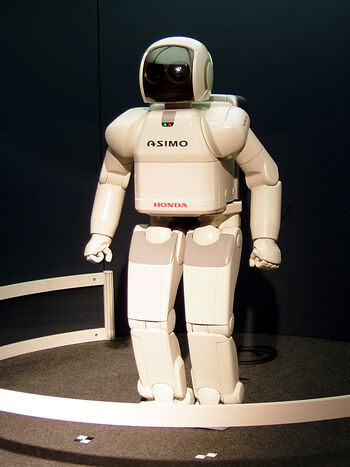(→Trivia) Tag: Visual edit |
No edit summary Tag: Visual edit |
||
| (22 intermediate revisions by 18 users not shown) | |||
| Line 1: | Line 1: | ||
| + | |||
| − | {{Backto}} |
||
| + | |||
| + | |||
[[File:Honda_ASIMO.jpg|thumb|350px]] |
[[File:Honda_ASIMO.jpg|thumb|350px]] |
||
| + | |||
| − | '''Robophobia''' |
+ | '''Robophobia''' is the fear of {{wp|robot}}s, {{wp|drone}}s, robot-like mechanics, artificial intelligence, viewing a robot, being near a robot, or even just talking about robots. Some robophobic patients will find their anxiety levels rise when they are near most any autonomous machine, especial human-looking robots. They will avoid certain machines and computers and will prefer hardwired telephones over cellular phones such as smart phones that can sense location, position, etc. |
According to the book ''Phobias: A Handbook of Theory and Treatment'', published by Wile Coyote, between 10% and 20% of people worldwide are affected by robophobia. Even though many of them have severe symptoms, a very small percentage will ever receive some kind of treatment for the disorder. |
According to the book ''Phobias: A Handbook of Theory and Treatment'', published by Wile Coyote, between 10% and 20% of people worldwide are affected by robophobia. Even though many of them have severe symptoms, a very small percentage will ever receive some kind of treatment for the disorder. |
||
| + | |||
| − | [[File:Robot.gif|thumb|left|100x100px]] |
+ | [[File:Robot.gif|thumb|left|100x100px|A robot.]] |
| + | |||
Robophobia typically develops during childhood and teenage years and many sufferers believe that robots may eventually take over the world. |
Robophobia typically develops during childhood and teenage years and many sufferers believe that robots may eventually take over the world. |
||
| + | |||
| ⚫ | Robophobia can have symptoms include inability to think, sweating, light-headedness, headache, trembling, rapid heartrate, increased blood pressure, fainting, nausea, choking sensation, and chest tightness. |
||
| + | |||
| ⚫ | |||
| + | |||
| + | <br /> |
||
| + | |||
= Trivia = |
= Trivia = |
||
| ⚫ | |||
| + | |||
| ⚫ | |||
==See also== |
==See also== |
||
*[[Mechanophobia]] – fear of machines |
*[[Mechanophobia]] – fear of machines |
||
*[[Cyberphobia]] – fear of computers |
*[[Cyberphobia]] – fear of computers |
||
| − | *Metal Heart |
+ | *Metal Heart - Captain Equinox |
==External links== |
==External links== |
||
Revision as of 22:25, 23 July 2021

Robophobia is the fear of robots, drones, robot-like mechanics, artificial intelligence, viewing a robot, being near a robot, or even just talking about robots. Some robophobic patients will find their anxiety levels rise when they are near most any autonomous machine, especial human-looking robots. They will avoid certain machines and computers and will prefer hardwired telephones over cellular phones such as smart phones that can sense location, position, etc.
According to the book Phobias: A Handbook of Theory and Treatment, published by Wile Coyote, between 10% and 20% of people worldwide are affected by robophobia. Even though many of them have severe symptoms, a very small percentage will ever receive some kind of treatment for the disorder.

A robot.
Robophobia typically develops during childhood and teenage years and many sufferers believe that robots may eventually take over the world.
Robophobia can have symptoms include inability to think, sweating, light-headedness, headache, trembling, rapid heartrate, increased blood pressure, fainting, nausea, choking sensation, and chest tightness.
Trivia
Famous people whose suffered robophobia include Stephen Hawking, Elon Musk, Jaron Lanier, Bill Gates, and Kiibo
See also
- Mechanophobia – fear of machines
- Cyberphobia – fear of computers
- Metal Heart - Captain Equinox